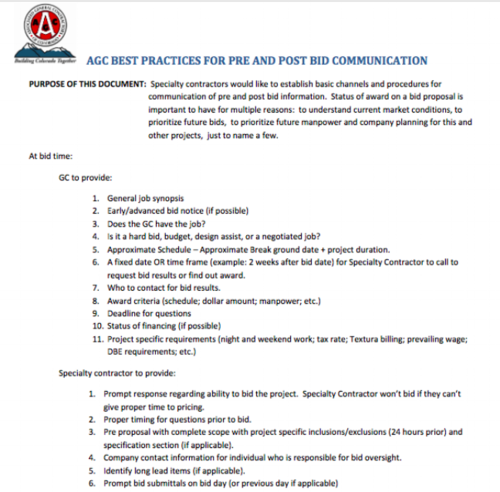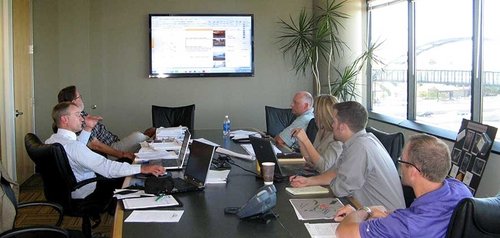
When jack-of-all-trades Tim Sinclair left AGC’s National Convention in Las Vegas last week, he brought with him yet another new title: chair of AGC’s Specialty Contractors Council (SCC).
A former estimator, project manager, and general contractor, the Wichita KS-based Sinclair this spring will mark 15 years as owner and president of both Sinclair Masonry Inc. and Pal’s Glass Service. On top of that, he also runs a structural steel fabrication business and rebar shop. So, to say that Sinclair knows construction inside and out is not an exaggeration. In fact, his multiple perspectives as both a sub and former GC make him an ideal spokesman on the subject of pre-construction services, the focus of a panel discussion on which he participated last week entitled, Maximize the Performance of the Pre-Construction Process through Pre- and Post-Bid Communication.
BuiltWorlds caught up with Sinclair this week to discuss the “best practices” put forth by that panel.
BW: Tim, thank you for your time. How did the pre-construction panel go last week?
TS: Very well. Three years ago, we had only eight attendees, but this year, there were about 90, which made it one of the biggest educational sessions at the convention. It was moderated by Steve Boughton of FMI and included outgoing SCC chair Craig Clark, President/CEO of Dynalectric in Denver CO; Curt Campbell, a VP with JE Dunn in Tempe AZ; and Byron Haselden, President/CEO of Denver’s Haselden Construction. Coincidentally, the AGC chapters in Colorado and Kansas had developed separate Preconstruction Best Practices for their respective groups, so we were happy to share them with everyone there, and anyone else who is interested now. (The sheet is appended below.)

BW: Your best practices and even the title of last week’s panel really stress the importance of open communication between GCs and subs. Is that the key to effective preconstruction collaboration?
TS: Yes. It’s not everything, but it’s at least 80%. Communication — and not just via e-mail, but face-to-face — is definitely the most important. That’s really the meat of why we are doing this. Eight years ago when I joined the SCC group at AGC of Kansas, the only thing the specialty contractors (SC) wanted were contract terms changed to make it easier on them: i.e., quicker payment terms, fewer clauses in contracts that hurt them, etc. We fought for those items for four years to zero success. We then decided to attack it from the angle of showing GCs what they could get out of it. We held a chapter roundtable and called it, How to Improve the Performance of your Subcontractor through Project Scheduling!
“We all know what we learned climbing up the ranks of the industry or in the classroom, but it’s the day-to-day needs of all of us that make us more of a team. We are all contractors that work on the same jobsite and these roundtables help us all work better and be more productive together”
We had a full room of GCs and subs and it was supposed to last two hours. Four hours later, we had a room fully engaged and wanting more. So, we then began to schedule these roundtables quarterly, and they have been a huge success. The reason being that both sides discuss exactly what they need and why they need it. It’s really been amazing. We all know what we learned climbing up the ranks of the industry or in the classroom, but it’s the day-to-day needs of all of us that make us more of a team. We are all contractors that work on the same jobsite and these roundtables help us all work better and be more productive together. I spent 12 years working for GCs, so I completely understand both sides.
BW: Talk a bit more about that GC experience. How does it inform your work with other subs?
TS: Most SCs don’t know what it looks like from the GC’s side. Just take bidding a project on bid day. Most SCs think they submit their bid, the GC has a couple hours to review it and then diligently make its decision. But from my experience, I know that it’s an absolute madhouse in the bid room: papers flying everywhere; estimators cussing at each other; everybody looking for the low SC; and then literally submitting their bid about 48 seconds before the deadline. So we have outlined in our Best Practices for submitting the “Scope of Work” letter the day before the bid, and then the “Proposal” the day of the bid. Our GCs (in Kansas) are requiring SCs to use this format now so that it makes the bid process smoother on their end, and it also makes sure the SCs have an apples-to-apples proposal. It’s literally the little things like that that can change this industry for the better.
BW: So, given the pressure all parties are under, the more details they share earlier, the better.
TS: Yes, there are several ways we can do what we do better. For instance, if SCs submitted clearer and more precise Proposals, then the GC would be able to spend more time making sure they were complete instead of just looking at the low number and finding out the next day that they are $500,000 low. So, it’s a matter of SCs knowing exactly what we can do to help the GCs be more effective with their time, and the GCs seeing what they can do to help the SCs be more productive with their time, too.

BW: How has technology affected pre-construction services?
TS: On the good side, it has allowed all contractors to look at, and bid more jobs due to the drawings being electronic and viewable any place at any time. This allows all contractors to look at more projects to bid and to filter out the ones that fit their niche. So it has also expanded the geographic region where SCs can bid work because now they don’t have to pay to have drawings shipped into their office before they decided if they are going to bid the project or not… On the bad side, it has really reduced verbal communication, and that’s not a good thing. I heard last week, time and time again, that if an SC gets an actual phone call on a job, they are much more likely to bid it rather than if they just receive an email with an invitation to bid… Technology has reduced some costs, so that’s definitely good for the industry. And it has reduced the time it takes to order drawings, mail drawings, review them, and then decide if you’re going to bid or not. But ironically, it has also expanded the number of GCs that you now have contentious relationships, basically by expanding the geographical area that contractors can work in.
BW: So, you don’t see technology as the cure-all. But you still seem very optimistic about these historically contentious relationships in our industry improving. Why is that?
TS: People in this industry have always been stuck in their ways, but we’re in a new world now. The crowd I saw in Las Vegas last week was just younger and had more energy than any I have seen before. And these face-to-face roundtables have really encouraged me. I truly believe we can change the construction industry by sitting in a room together and talking to each other. It not only helps us know what each other needs but also makes us at least act like we like each other. And usually we all do. We just get contentious sometimes because we don’t realize what other people really need. If we could figure out how technology can help with that, then we would reinvent this industry!
BW: Thanks for that optimism, and for your time, Tim. Good luck with all your many hats!
TS: You are certainly welcome. And thank you. It promises to be a very busy year.





Discussion
Be the first to leave a comment.
You must be a member of the BuiltWorlds community to join the discussion.